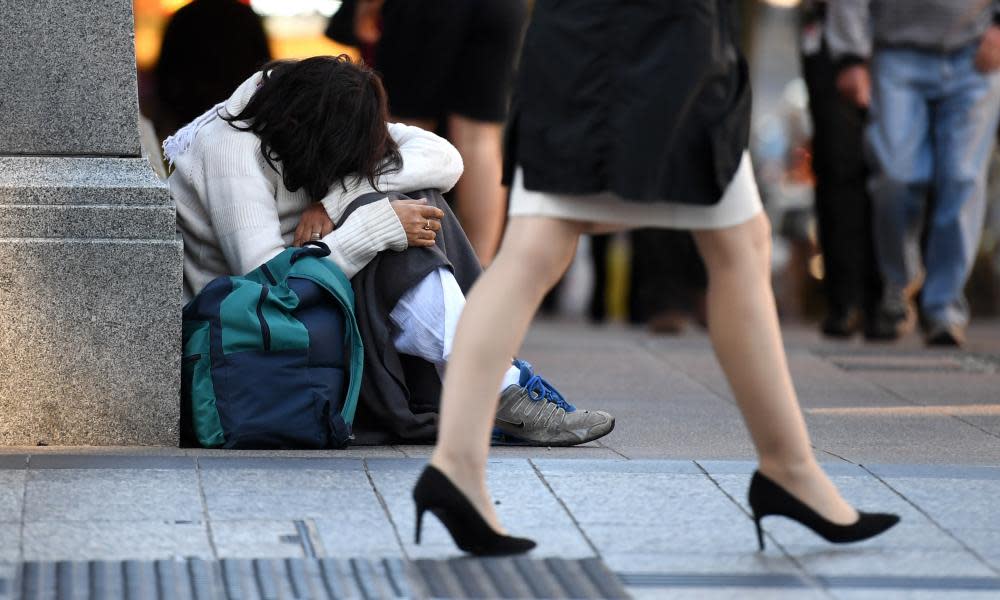Women majority of newly homeless, as ABS census data shows problem getting worse

The number of people experiencing homelessness in Australia has grown 5.2% in five years, with women making up the vast majority of the newly homeless and more than a third of all homeless people aged under 25, new data has revealed.
The Australian Bureau of Statistics on Wednesday released its latest homelessness estimates based on the census on 10 August 2021.
More than 122,400 people were homeless on census night, the data showed, with Aboriginal and Torres Strait Islander people severely overrepresented, comprising one-fifth – 20.4% – of all homeless people on census night, despite First Nations people making up 3.8% of the population.
The number of women and girls experiencing homelessness has increased by about 10% since the previous census in 2016.
Related: ‘Now you’re evicting them?’: Victorians in ‘life-changing’ housing scheme face homelessness again
The new data gives the most up-to-date indication of homelessness in Australia, but also “reflects the unique accommodation circumstances of those experiencing homelessness at the time of the census”, the ABS analysts said. The data reflects the consequences of temporary housing measures undertaken during Covid-19 lockdowns that were in place in some states.
Social services organisations say the new figures highlight the urgent need for state and federal governments to act.
The rates of homelessness have increased for people aged under 18 since 2016, with the 17,646 children under the age of 12 who were homeless on census night representing the second-largest age group overall.
Nearly a quarter, or 23%, of people experiencing homelessness were aged between 12 and 24, while people under the age of 25 comprised over 37% of all homeless people.
The rate of homelessness for people aged over 55 decreased from 29 people per 10,000 in 2016 to 26 people per 10,000 in 2021. Older people, however, still comprised 15.8% of people experiencing homelessness.
Rates of homelessness were worst in the Northern Territory, with 564 people per 10,000 experiencing homelessness.
People living in severely overcrowded dwellings represented two out of every five people experiencing homelessness, or 39.1%. Living in severely overcrowded dwellings has been the most common manifestation of homelessness for the last five censuses, though the overall proportion has declined slightly, by 6.3%, since 2016.
“Severe overcrowding” is defined as a dwelling that would require four or more extra bedrooms to accommodate the usual occupants.
Related: ‘It’s Up to Us’: squeezed by the housing crisis, a NSW rural community finds its own solution
Aboriginal and Torres Strait Islander people were the most likely to be experiencing homelessness of this kind, with 60% of those experiencing homelessness living in severely overcrowded dwellings. Homelessness among Aboriginal and Torres Strait Islander people was worst in the Northern Territory, followed by Western Australia and South Australia.
Rates of homelessness increased significantly in Victoria, up from 42 to 47 people per 10,000, making it the state with the second-highest rate of homelessness in the country. Victoria had 30,660 people experiencing homelessness on census night, despite lockdown-specific emergency housing measures in place at the time, up from 24,817 in 2016 – an increase of 23.5%.
Victoria had the largest proportion of people living in boarding houses, at 28%. Australia has seen a 26.5% increase in people living in boarding houses overall, equating to one in six homeless people, or 18.1% in total.
Related: Federal minister urges Australians to help tackle homelessness ‘in their back yard’
The federal minister for housing and homelessness, Julie Collins, acknowledged the increase in homelessness in parliament question time on Wednesday, saying it was unacceptable.
“There is a lot to do to turn this around,” Collins said. “We all need to do more. All of us in this place have a responsibility to make sure that more Australians have a safe, affordable place to call home.”
Collins argued that the new data was a reason why the Senate should support the housing Australia future fund, a Labor scheme to invest $10bn and then spend the earnings on social and affordable housing projects.
The Coalition, the Greens and key crossbench senators object to the scheme, with many arguing it isn’t ambitious or robust enough.
Social services organisations around Australia have argued that the new data highlights the desperate need for new government-funded housing programs.
Related: The never-ending fallout of the northern rivers floods: ‘People are just worn down’
The chief executive of the Council to Homeless Persons, Deborah Di Natale, said the escalation of homelessness in Victoria was alarming.
“These grim numbers show exactly why the Victorian government must fund highly successful programs like From Homelessness to a Home, which provides stable housing and support for people who are sleeping rough,” Di Natale said.
Aboriginal Housing and Homelessness Forum chair and the chief executive of Aboriginal Housing Victoria, Darren Smith, said a minimum of 300 houses a year for First Nations people needed to be built in Victoria and 10% of all social housing stock created through the federal government’s proposed Housing Australia Future Fund needed to be allocated to First Nations people.
The chief executive of Mission Australia, Sharon Callister, said levels of homelessness in Australia had been exacerbated by the “long-term absence of a serious and sizeable commitment” from governments to building new social and affordable homes.
“The severe shortage of social and affordable housing, a private rental market that is extremely unaffordable across metro and regional Australia and soaring cost of living are accelerating Australia’s housing and homelessness crisis,” Callister said.

 Yahoo News
Yahoo News 
